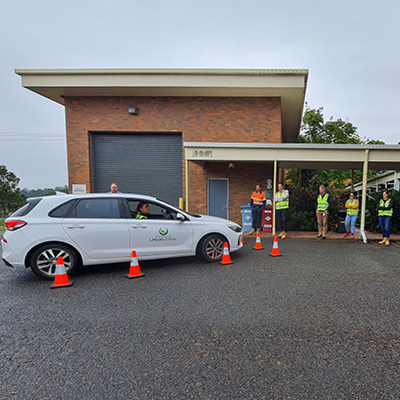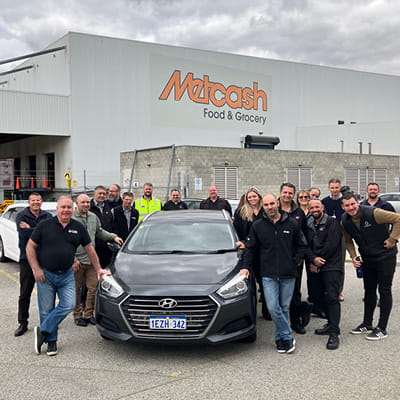How workplace vehicle safety training can save businesses thousands
- For every $1000 spent on repairs, a business loses an average of $5000 after a work vehicle accident
- By prioritising safe driving in processes from onboarding thorough to employee training and incentives, businesses can significantly reduce workplace vehicle accidents
- QBE’s Workplace Vehicle Safety Program tailors training to the road incidents experienced by your business
How high is ‘safe driving’ on your list of desirable attributes for potential new employees?
If the job you’re recruiting for includes driving company vehicles, it should be an important consideration – because how employees act behind the wheel can have a major impact on your business, including your bottom line.
From the costs incurred as a result of an accident (think insurance claims, time off the road, employee injury and potential workers compensation claims) to brand reputation (after all, it’s not a good look to see a business-branded vehicle involved in an incident), the total impact on the business can quickly add up.
“From conversations we have with clients, our estimate is that every $1000 QBE spends fixing a vehicle, a business loses approximately $5000 on average, due to the consequential impacts,” says Ken Arthur, National Risk Manager, Commercial Motor, at QBE.
“For fleets comprising mostly sedans, SUVs, utilities and vans, that figure can be lower. However, for a heavy vehicle fleet, it may be $15,000 or more.”
Driver training can help reduce common fleet vehicle accidents
There are many reasons why accidents in work vehicles may take place, and when it comes to common claims, approximately one in three claims are for hard–to-avoid accidents such as broken windscreens or storm damage. The next most common are accidents caused by high-risk driving, such as losing control, rear-ending or disobeying signals1.
“Surprisingly, approximately one in four claims are from low-speed accidents, such as hitting objects in car parks while moving forward or reversing2,” says Arthur.
Ken and his colleague, fellow National Risk Manager of Commercial Motor, Robert DiPierdomenico, manage QBE’s Workplace Vehicle Safety Program, which helps businesses reduce workplace vehicle accidents, saving them money and helping them to achieve cultural change.
“On average, after taking part in the program, we’ve seen businesses typically experience a 25 per cent reduction in the number of claims, and a 30 per cent reduction in the cost of claims,” says Arthur.
“As well as helping reduce the number of incidents and cost of claims, improving workplace vehicle safety may also help reduce associated costs too, including fuel costs and wear and tear, because drivers are more conscious about what they’re doing every day.”
Reduce vehicle accidents at work – why management buy-in is critical
Regardless of whether a business needs to address specific problems or simply wants to provide employees with a safe driving refresher, one thing is essential – the desire from management to embrace change.
QBE’s workplace vehicle claims reports provide valuable insights for both businesses and brokers to identify problem areas and help provide solutions, while the online Fleet Risk Assessment Tool can also be used by fleet managers to identify potential areas of improvement in a business’s approach to fleet management.
“If you’ve got the buy-in from the top, it’s going to filter down to the rest of the business,” says DiPierdomenico.
“From what we’ve witnessed with our customers, accidents aren’t always due to the driver’s skill, they may be the result of attitudes, culture or behaviour – and there’s got to be a strong desire from management to help their employees become safer drivers.”
Given the importance of management buy-in, it’s no surprise the first step in QBE’s approach to improving workplace vehicle safety is a meeting with fleet managers to delve into the business’ key areas of improvement, as well as developing an understanding of their current approach to driving safety.
“In terms of how the business approaches driving, we like to look at four categories – pre-employment, induction, what they do at the time of an accident, and ongoing initiatives and training,” continues DiPierdomenico.
“From there, we look at their data and industry trends and have a conversation with management about the reasons why certain accidents may be happening.”
The approach is one of collaboration, with the aim of creating a manageable solution that focuses on the key causes of incidents.
“We don’t walk in and tell them what they’re lacking and what they should be doing,” says Arthur. “It’s a genuine collaboration, with our suggestions based on what the business can realistically achieve with the resources it has available.”

Workplace vehicle safety program in action
Following the session with fleet managers, an on-site workshop is arranged for their employees, which incorporates a mix of safety training, risk management education and practical in-vehicle activities.
With a focus on behaviour, ego, temperament, motivation and culture, the Workplace Vehicle Safety Program has gained rave reviews from fleet managers and their employees.
“Based on our consultation with management, we identify the two accident types the business should target that will see the greatest reduction in numbers and cost, and then gear the session to solving those incidents – because if they can start to get those under control, the rest takes care of itself,” says DiPierdomenico.
“Our team will also share the company’s claims data and reports with their drivers, workshop reasons for those incidents occurring, and help drivers understand the changes in behaviour that could have a significant impact on the business.”
Urban Utilities achieves a 90 per cent reduction in targeted claims
Brisbane-based Urban Utilities delivers drinking water, recycled water and sewerage services to more than 1.4 million people in Southeast Queensland3, and has more than 500 vehicles4.
QBE began working with the business in 2019, and initially delivered an on-site trial session to allow management to assess the training and impact before rolling it out company-wide. The trial was incredibly well-received and since its post-pandemic reintroduction, sessions have been delivered every quarter to different teams across Urban Utilities.
“Our decision to continue with the program was due to QBE’s ability to deliver important information in a captivating way, as well as the positive feedback we received from our participants,” says Brodie Pigram, Risk Solutions Specialist for Urban Utilities.
“The training started some great conversations and gave us with an opportunity to engage business areas that we wouldn’t ordinarily interact with.”
While the sessions proved enjoyable, they also proved impactful – with the company seeing a 90 per cent reduction in its top two causes of claims – hitting a roadside object and rear-end accidents5.
Marvie Angeles, Maintenance Delivery Lead Control System Service Delivery for Urban Utilities, says, “The training is focused on driver behaviour and identifying driving risk patterns. One can be an experienced driver, however, can still get into an accident due to poor judgement/miscalculation of risk.
“It’s aimed at the stage before an accident – prevention – which a lot of our employees find value in. Employees have approached us to say that they apply what they have learned in the sessions in their personal life too.”

Metcash helps drivers improve safety on the road
It’s the impact on employees’ personal lives that was a priority for major wholesale distributor Metcash, which operates brands including IGA, Campbells, Mitre 10, Home Hardware, Total Tools, The Bottle-O and Cellarbrations – as the business’ National Fleet Administrator, Tracy Rollins, explains.
“When our Fleet Standards (policies) changed, we took the opportunity to educate our drivers on vehicle safety. We wanted to help our drivers understand that Metcash takes driver safety seriously and ensure that our drivers follow through with our ‘Home Safe Every Day’ slogan.”
As part of the business’s Driver Safety Week initiative, QBE was invited to hold a workshop session to provide drivers with some insight and inspiration to mitigate vehicle related incidents.
After discussing accident and trend data, a conversation with employees explored why the accidents could occur and was followed by a simple car manoeuvring exercise that demonstrates what happens when drivers rush.
“Our attendees absolutely loved QBE’s sessions. We do have good drivers, but showing them internal and industry trends on claims numbers and spend really opened their eyes,” says Rollins.
Creating lasting vehicle safety change
While one session may address immediate issues, it’s important for this to be the beginning of lasting change, by evolving the way the company recruits and onboards drivers, considering ongoing training requirement needs, and implementing initiatives that incentivise good driving.
“There are a range of tools that can be used to improve driving standards long-term – for example, businesses may want to consider telematics, or incentive or disincentive schemes. We work closely with the management team to help establish what will work for them,” says Arthur.
“Some companies like to gamify it and share incident data across the company, and reward those who drive safely. Sometimes we’ll do follow-up training – whatever it takes to keep those messages alive and heard.”
Find out more
QBE offers risk solutions for businesses using fleets of any size. For tailored information, contact your QBE Partnership Manager or speak to your broker.
For more fleet risk insights, visit our fleet risk management page.
1 QBE Fleet Vehicle Accident data by category – June 2016 to June 2023
2 QBE Fleet Vehicle Accident data by category – June 2016 to June 2023
3 Urban Utilities
4 QBE Commercial Motor customer data 2023
5 QBE Commercial Motor claims data 2023
